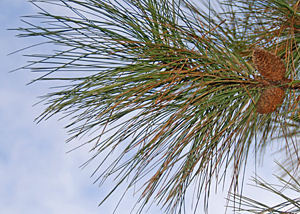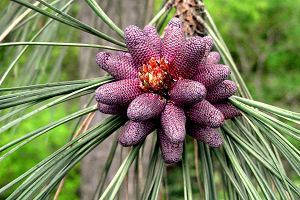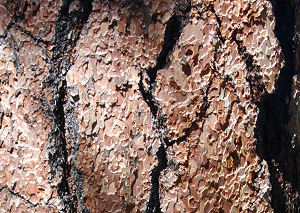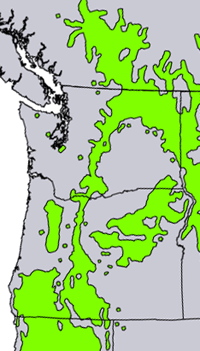
Needles: Ponderosa Pine has 3 needles per bundle. The needles are up to 10 inches long, with sharp points. Ponderosa Pine is easy to identify outside of southwest Oregon because it is the only 3 needle pine in the rest of the Northwest.

Cones: The egg-shaped cones are 3 to 6 inches long and have a sharp point on each scale.

Pollen cones
Bark: The bark is the most striking and distinctive characteristic of this pine, with flat red or yellow plates shaped like the pieces of a jigsaw puzzle. The bark is more colorful on older trees, most notably on large trees growing east of the Cascades.

Where it grows: Ponderosa pine is common throughout much of the western US. It is the most common conifer in the Northwest east of the Cascades, growing at elevations up to 5000 feet. Although it thrives in dry, mountainous regions, it is also native to the wet habitat of the Willamette Valley, but there the bark loses some its distinctive color. Ponderosa pine is the state tree of Montana.
Ponderosa pine at Hoyt Arboretum

If you travel farther east, you will encounter Rocky Mountain ponderosa (subsp. scopulorum), which grows throughout much of the northern Rocky Mountains.
Similar Tree: Jeffrey pine grows in southwest Oregon and California.
Uses: Ponderosa pine lumber is widely used in home construction, window and door frames, moldings, and furniture. Squirrels, chipmunks and many kinds of birds eat the seeds. Some cache the seeds, which facilitates the propagation of more pine trees.
Names: Lewis and Clark encountered this pine in 1805 and were impressed by its long needles. In 1826, David Douglas named it for its heavy (ponderous) wood. Other common names: yellow pine, western yellow pine, blackjack pine.